German Shepherds are the poster boys for Shepherd dogs everywhere, but there are a few others, like the Blue Heeler dog, for one, that can give them a run for their money, so what happens when one does a German Shepherd vs Blue Heeler comparison?
In the German Shepherd vs Blue Heeler square off, the two do look similar visually, but one is definitely smaller than the other, though there are more differences than just those related to the aesthetic hidden under the hood.
While the GSD certainly has the strength behind him and the imposing figure, the Australian Cattle Dog has the nimbleness and dexterity as well as his high levels of intelligence to back him up.
Both were raised to be both working dogs and herding dogs, though the German Shepherd has since expanded into other fields too.
Though there are parts where the Blue Heeler shines too, namely in his innate friendliness and use as a therapy dog, even though both share that potential quality if proper training is conducted.
So, if you want to find out which of these two stellar breeds is the better choice and why, be sure to read on.
German Shepherd Vs Blue Heeler Dog: The Rundown
The German Shepherd
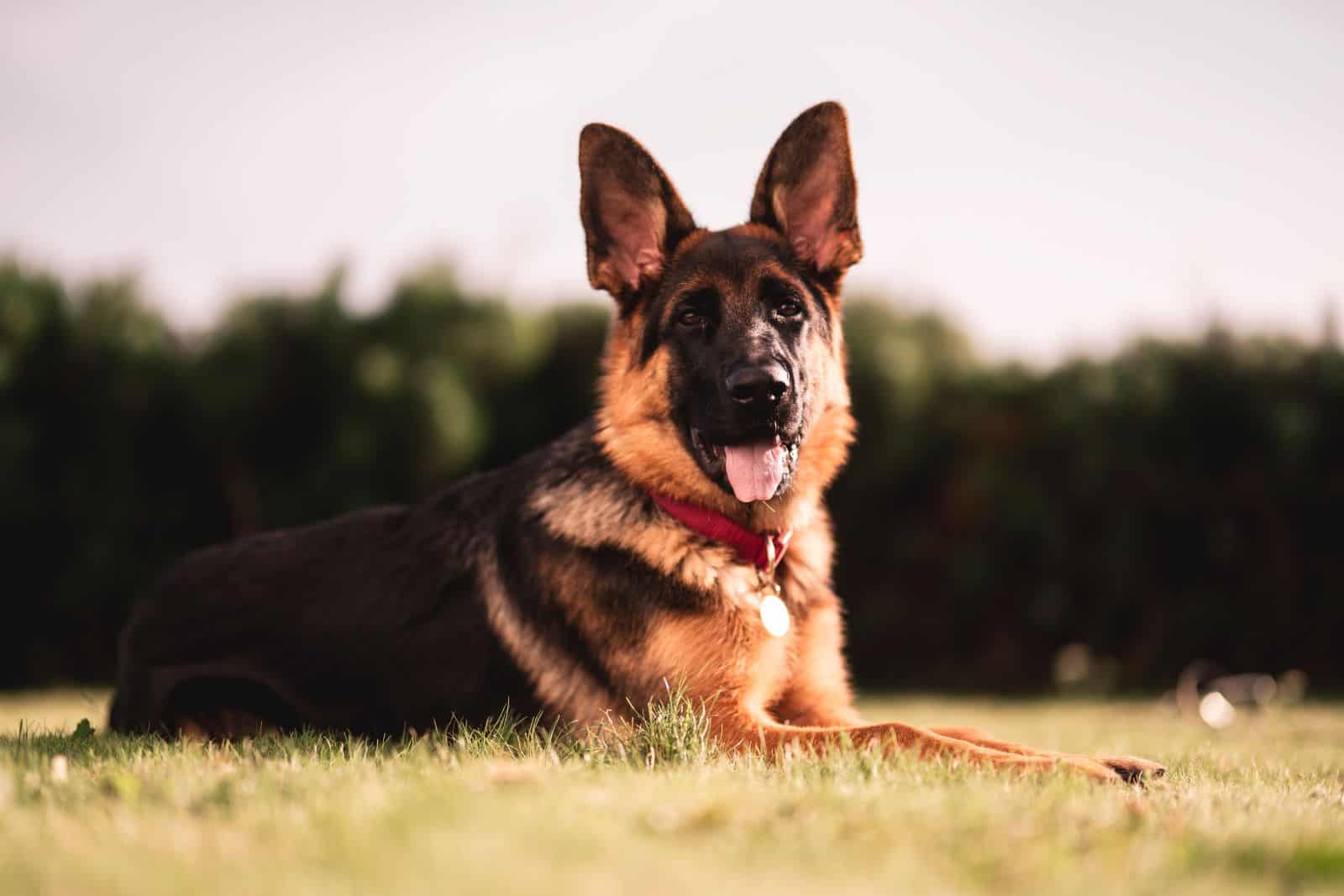
First up is the German Shepherd, the first breed that comes to mind when thinking of discipline and defense, the ideal watchdog.
Breed History
The German Shepherd, despite being one of the flagstone representatives of dog kind, is surprisingly not that old a breed, only coming in the late 1800s.
Before the year 1891, there weren’t any particularly standardized dog breeds in Germany, at least as far as their shepherd dogs were concerned, instead there were plenty of breeds that performed similar duties, but had vast physical differences.
The so-called Phylax Society remedied that as it aimed to have the breeds conform to some sort of standard, or at least it tried to, but failed, though it was an inspiration for people to continue their work further down the line.
One man in particular, captain Max von Stephanitz, around the year 1899, saw the product of one of the first generations of German Shepherd, one raised through a lot of selective breeding and made to be the ideal working dog, at least in the eyes of Stephanitz.
He’d buy the dog and found the Society for German Shepherd Dogs of which his pooch, Horand von Grafrath, would be dubbed the first registered GSD of.
News spread fast and the society gained in popularity at a breakneck pace, gaining more and more members not just in Germany, but internationally, all of which wanted to be part of this legacy.
The first GSD fathered an astonishing number of children who would only continue on that route, primarily dealing with inbreeding in order to maintain the traits Stephanitz coveted so dearly.
The first modern GSD, one with the traits we know today, is believed to be Horand’s son, Beowulf.
Given the dog’s impeccable reputation, it was soon adopted to be more than just a working dog, but an army and guard dog as well, Nazi Germany in particular as it had the traits that their doctrine respected and they deemed it a good representative of it.
While a dark blemish on the breed’s otherwise stellar past, it’s one worth noting as the breed wasn’t at fault here.
They had other darker representations, namely being a favored breed of gangsters and other crooks of slightly higher caliber, but, in the later years, they also became a favorite for the police force, the well known K-9 units.
As for when they were introduced to our shores, that came around the year 1906, a little bit after they got popular in Germany and would get certified by the AKC (American Kennel Club) 2 years later, in the year 1908.
Appearance
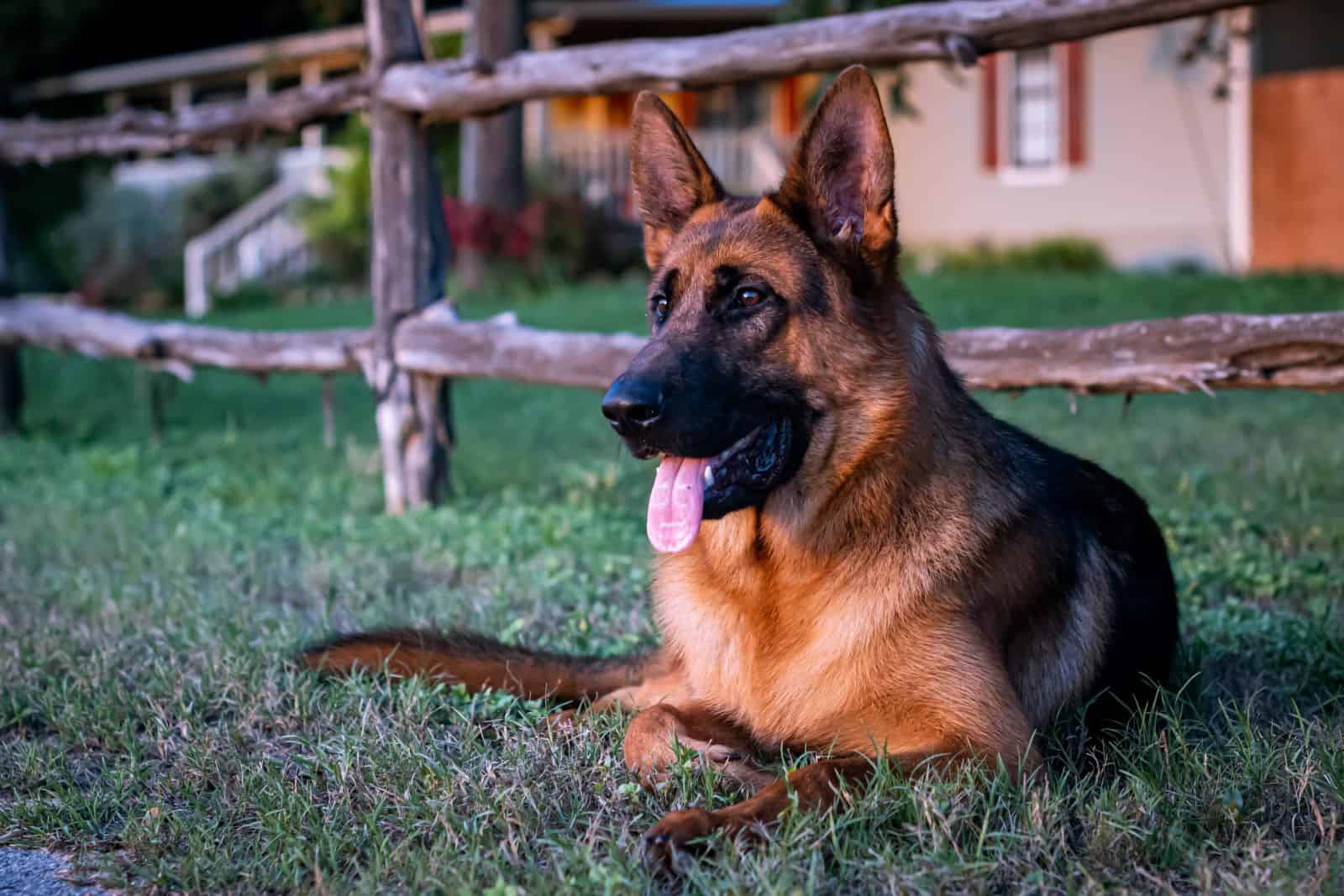
Most people have seen or already know what a German Shepherd looks like, but it’s still worth pointing some characteristics out.
They’re considered to be an intermediary between medium and large dog breeds, coming in at around 25 inches for male representatives and around 23 inches for the female GSDs height wise.
As far as weight goes, that one has a more drastic difference, with the males being bulkier, sporting an impressive 75-80 pounds on average as adults while females are leaner, only carrying around 57-62 pounds on average.
Though, even with that, there’s still a lot of wiggle room as to what’s considered a healthy weight.
Their head forms a rather imposing figure with their longer muzzle which appears like it was chiseled from a rock with its square features, a darker nose, large, sharp teeth and a very powerful jaw.
Aside from that their forehead is somewhat domed, making them appear as if they’re glaring at their target or as if they’re focused.
Then you have their ears which stand upright, as if on alert, and are rather large in comparison to their head overall.
Its head movements often resemble that of their lupine ancestors with their long necks and positional adjustment depending on the type of movement that it’s performing.
It can either be lowered to stalk prey or running, or raised when he notices something or someone of interest.
Moving over to the body, the GSD is covered in a nice and dense double coat paired together with a thick undercoat, keeping him nice and warm during the cold winter months.
While medium fur length German Shepherds are the standard, you can also find long haired ones, albeit they’re a lot less common than the former.
Said fur comes most commonly in the familiar mix of tan and black, but there are various other options out there paired together with their various black body markings, but more on that a little later.
Finally, they have a relatively long and bushy tail that completes the beautiful ensemble of the ‘ideal working dog’, as Stephanitz would put it.
Temperament
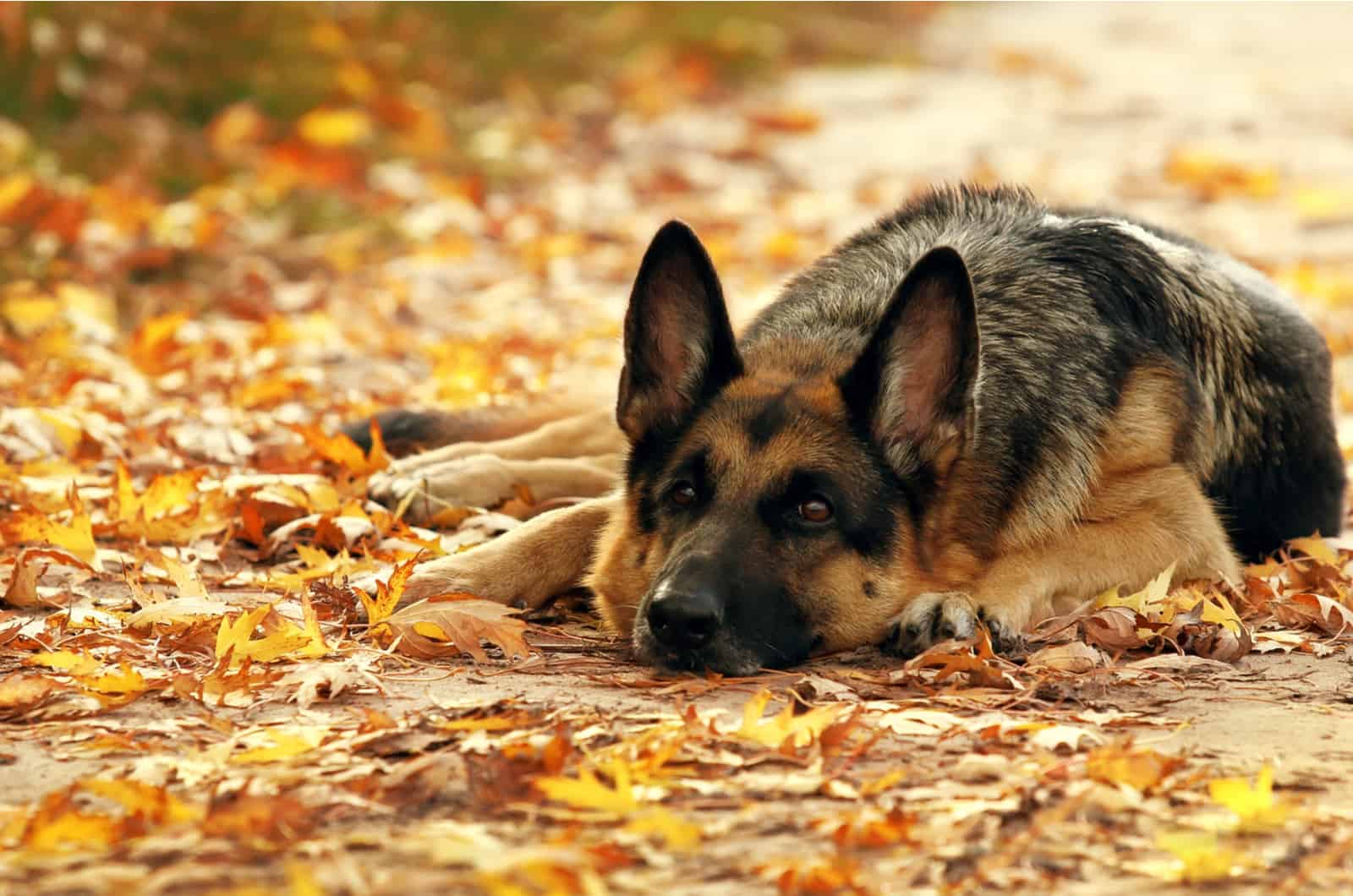
As mentioned before, a German Shepherd is the ideal type of dog in case you need one to guard property, watch out for intruders or be used as a general working dog due to their exceptional desire to do things and motivation to learn new things.
After all, their main intent was to be a herding dog, and they tend to not only be really active dogs, but also extremely intelligent ones.
They make for exceptional search dogs too once trained properly due to that same high level of curiosity toward discovery.
Aside from that, they’re highly favored as service dogs, whether it be in the position of being a military dog or handling police work.
That said, they certainly do have temper problems and aren’t recommended for people who can’t reign that in, especially first time dog owners.
They’re only really loyal to their family, but they tend to get a bit overprotective, wary of any strangers that may arrive at your doorstep.
On top of that, their high prey drive and ingrained shepherding nature will have them nipping away at your kids to try to get them to fall in line or similar which isn’t pleasant for them.
In terms of attacks on humans, they’re up there with Pit Bulls, albeit not nearly as common, but they are dangerous, mostly because people haven’t successfully trained them.
That’s why early socialization as part of their dog training is a must or else you’re going to end up with a problem on your hands.
Though, if you manage to complete their training properly they’ll be one of the most loyal and disciplined pets you could ever own.
Coat Colors
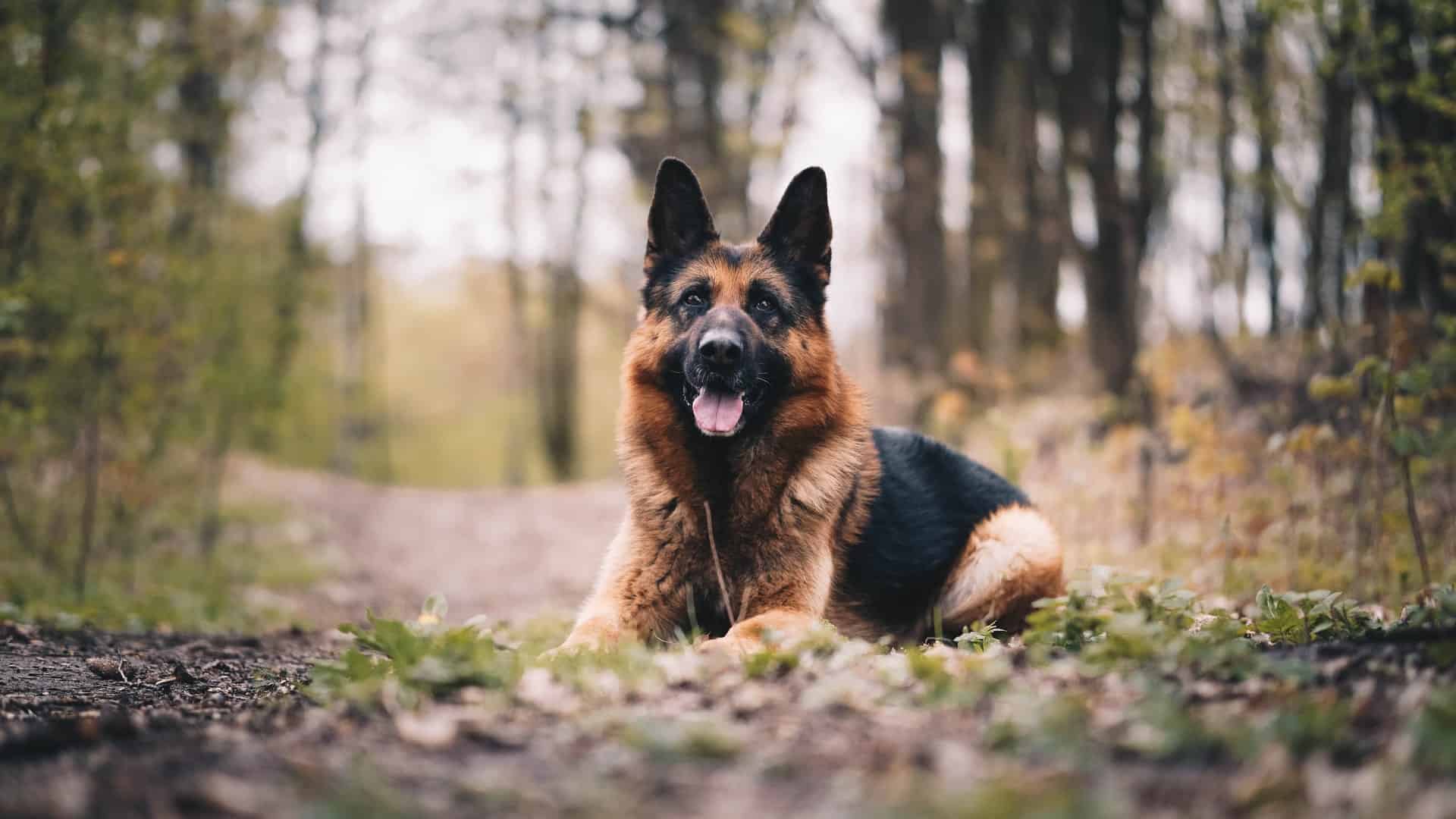
While the most common one that we end up seeing is black and tan, there are multiple other coat color options for the German Shepherd, albeit rare to see.
The standard colors are as follows:
- Black and Tan
- Black and Red
- Black and Silver
- Black and Cream
- Black
- Bi-color
- Sable
Of course, there are some non-standard ones too, albeit not approved by the American Kennel Club, though it only really matters if you’re looking to take your GSD to conformation shows.
Here are most of them:
- Gray
- Isabella
- Blue
- Blue and Tan
- Liver
- Liver and Tan
- White
Though, most, if not all of these colors can also come out lighter, seemingly washed out as well while still qualifying as a unique color.
Lifespan
The average lifespan of the German Shepherd is, by all counts, average when keeping large dog breeds into consideration, coming out at 9-13 years.
Despite seeming like too little, it’s the average for large breeds given how many health problems develop for them the older they get, particularly regarding the spine due to their center of gravity.
Through proper dieting and health check-ups, they can make that 13th year, but the average tends to be at around 10-11 years.
Grooming Needs
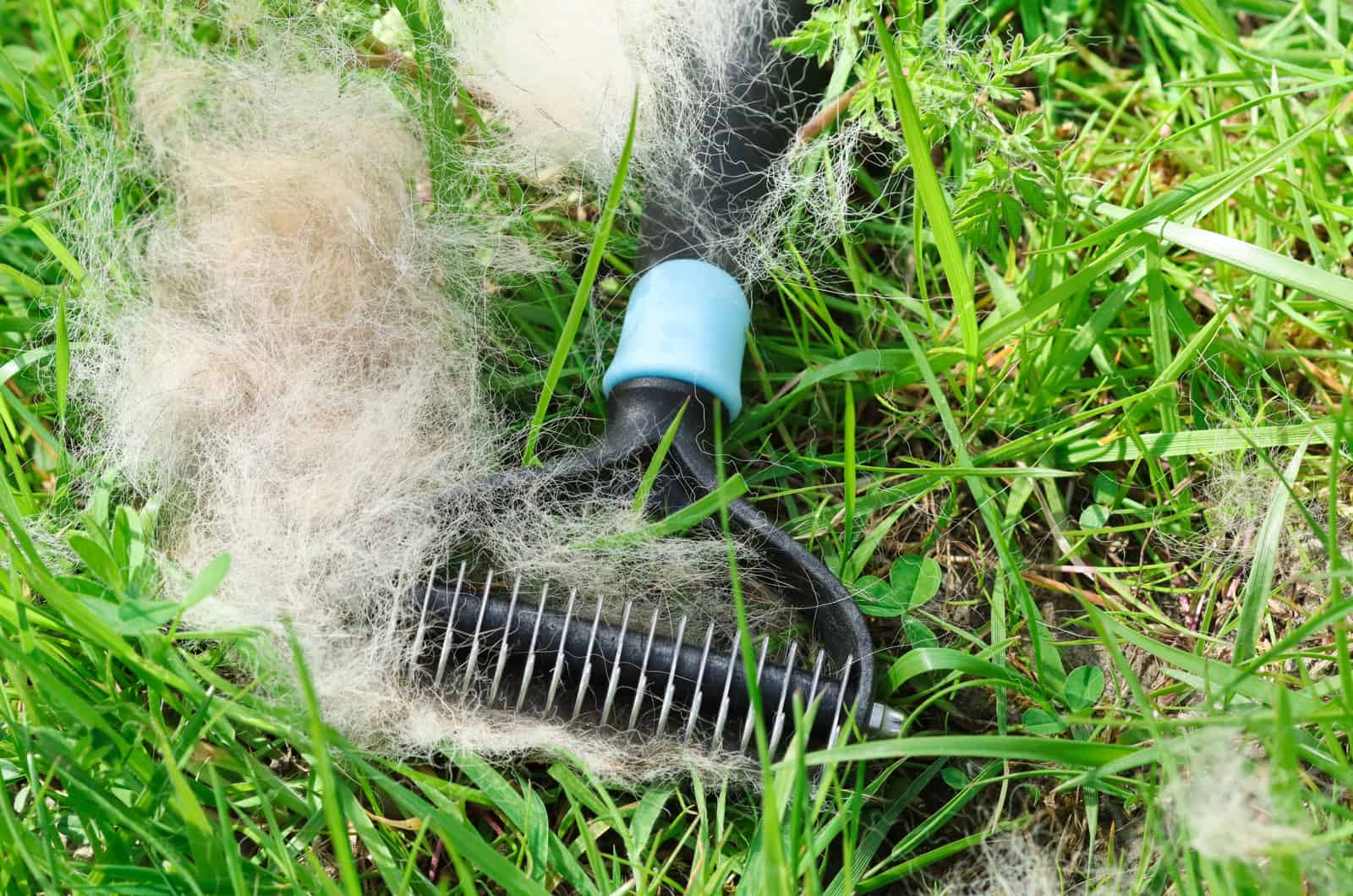
German Shepherds are considered to be moderate shedders and will often require brushing every other day.
That number can go up to once a day once shedding season really hits if you want to prevent any excess hair sticking to your furniture and all over your household, not to mention it helps keep your dog more comfortable once all the loose hair is out.
As for bathing, once every 6 weeks or so should suffice, the standard amount as dogs don’t really need to get bathed that often considering they’ll groom themselves more often than not.
Plus, frequent bathing will damage their fur and skin, even with the gentlest of shampoos.
Their nail situation should be inspected every week and kept trimmed by their pet parent when it grows out a bit too far.
It may not seem like much, but long nails are breeding grounds for infection and disease and keeping them neat and short will help improve your dog’s health overall.
And, as for exercise and keeping him in shape, German Shepherds are known for their high energy reserves, meaning they’ll need to get more exercise in than usual to match their activity level.
Around 2 hours of moderate exercise a day is recommended for them to help upkeep their muscle tone and keep them fit overall.
This doesn’t have to be done through walks alone, but can be done through play as well.
Health Issues

Despite being such a popular dog option, the German Shepherd is still a large dog breed and they’re a lot more prone to health issues than smaller ones.
On top of that, they do have a few hereditary problems which they’re more prone to as well.
Here are some of the more common issues regarding them:
Elbow And Hip dysplasia
The first issues that you’re likely to encounter are hip and elbow dysplasia, a problem where the ball and the socket of the joints get worn out due to friction and the former falls out of the latter, dislodging itself and leading to a great deal of pain for the dog.
It’s not a condition that can be cured, only whose chances of occurrence can be minimized so that it happens later on in life or not at all.
This way you’ll at least spare them the discomfort that comes along with it.
Pain medication can help, but keeping your dog at a healthy weight is the best method of prevention as it removes the extra stress on the joints themselves.
Bloat
Another, relatively common issue with most any dog, is bloat, a condition that happens due to the stomach twisting in on itself after a severe distension thanks to improper contraction.
This happens either due to eating directly after an exercise or not pacing oneself while eating.
It is as bad as it sounds too, with the contents of the stomach ending up trapped inside, whether they’re food, liquid or gas, but that’s not even the worst part.
Having the stomach twist like that can and will restrict blood flow to surrounding organs which can get real bad real fast.
If you notice your dog acting restless with a tense or clearly distended belly, or even dry heaving, take him to a vet immediately.
Despite being a very dire condition, it’s, thankfully, reversible, and the sooner you get him to a vet, the less likely the chance of any permanent damage will be after the procedure.
Degenerative Myelopathy
A pretty serious, albeit non fatal condition that’s inherent in every GSD.
Thankfully, it mostly happens in their twilight years, so there’s a good chance that it can be avoided, but it’s still a risk you should be aware of.
Degenerative Myelopathy is a condition that causes a progressive lack of motor function in a dog’s hind legs at the start, and can extend to his forelegs too if allowed time to progress.
It also involves incontinence at a certain point, which can lead to a real messy house unless you deal with it properly.
The early stages can be solved through the use of a doggy wheelchair of some kind, but the late stage form of it usually leads to the dog being put down for his own good.
Unfortunately, there is no cure, though, much like with hip and elbow dysplasia, you can potentially delay it or minimize the risk of it occurring through physical therapy.
Pannus
Finally, there’s one more condition that’s hereditary for the German Shepherd that you should be aware of, Pannus.
While not something immediately dangerous, it is something that your dog will have to deal with for the rest of his life.
It’s a condition that causes a pinkish mass to start slowly jutting out from under his eyelids.
It will mostly cause irritation at the start, but if allowed to progress too far, can lead to loss of vision or total blindness for the affected canine.
Smoke and increased exposure to UV light can expedite the condition, but various topical ointments and steroid injections can help slow, halt, or even reverse the progression of the condition in some cases.
Cost
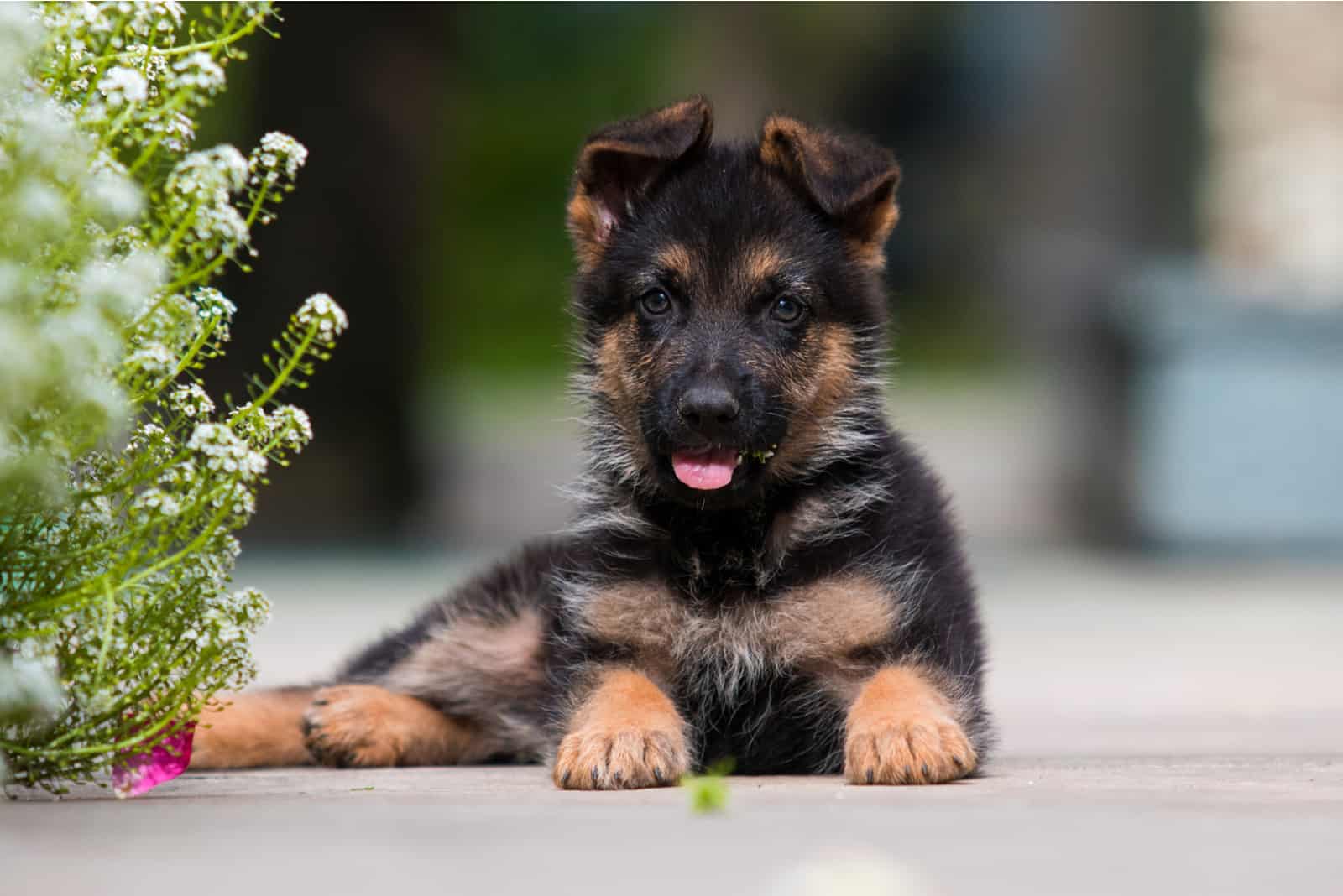
The German Shepherd, despite being one of the more useful dogs to have around your home, doesn’t cost as much as some show dogs do, coming in at a pretty standard cost, albeit with a wide range of differences.
You can get them for as low as $450 and as high as $1900, depending on level of training, accolades and genes among other benefits.
It’ll vary from breeder to breeder, but the average price that you should be expecting would be around $900-$1000.
As always, that’s not the only cost you should be aware of, as there are health bills to be considered, as well as costs for dog gear, food and the like which will amount to a lot more than the initial dog purchase price.
I know that you may be a dog lover, but you need to make sure that you can financially support a new addition to your family without it being a detriment in the long run, both for your sake, and the dog’s.
The Blue Heeler Dog
Breed History
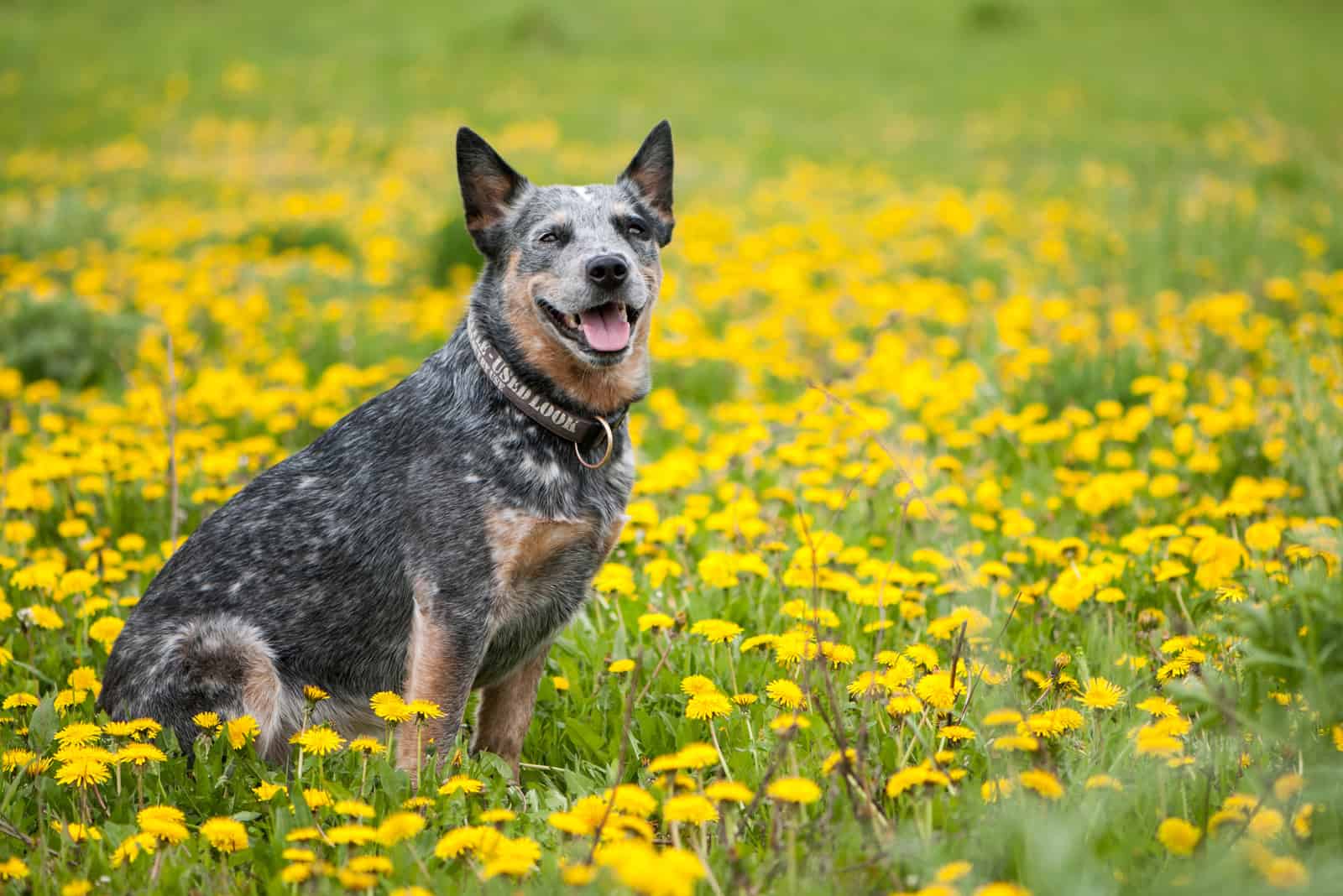
A cross between the Drover Dog and the local Australian Dingo, this wonderful dog breed emerged around the year 1840 and was deemed the best dog breed to be able to handle the harsh Australian climate.
However, the dogs didn’t become publicly available for another 30 years, after their breeder, Thomas Hall, passed away, the same man responsible for their alternate title, the Heeler dog.
Around the year 1903, they were considered to be an official breed by the Australian breed clubs, though they did receive a few changes to the breed standard in the following years which led to a lot of discourse in the Australian Cattle Dog club.
This somewhat muddled the records of the breed’s proper origins, but they were properly arranged later.
They arrived on our shores somewhere in the 1940s, but weren’t yet accepted by the AKC.
Through several failed attempts and the eventual expulsion of the veterinarian, Alan McNiven for trying to get the dogs registered through dubious means, he would eventually introduce some of the US soldiers to the breed who would then return it back to the States.
It took almost 40 years, in the year 1980, for the breed to be properly recognized by the American Kennel Club after a lot of back and forth between several representatives who sought to bring Blue Heeler breed into the fold of the United States.
Appearance
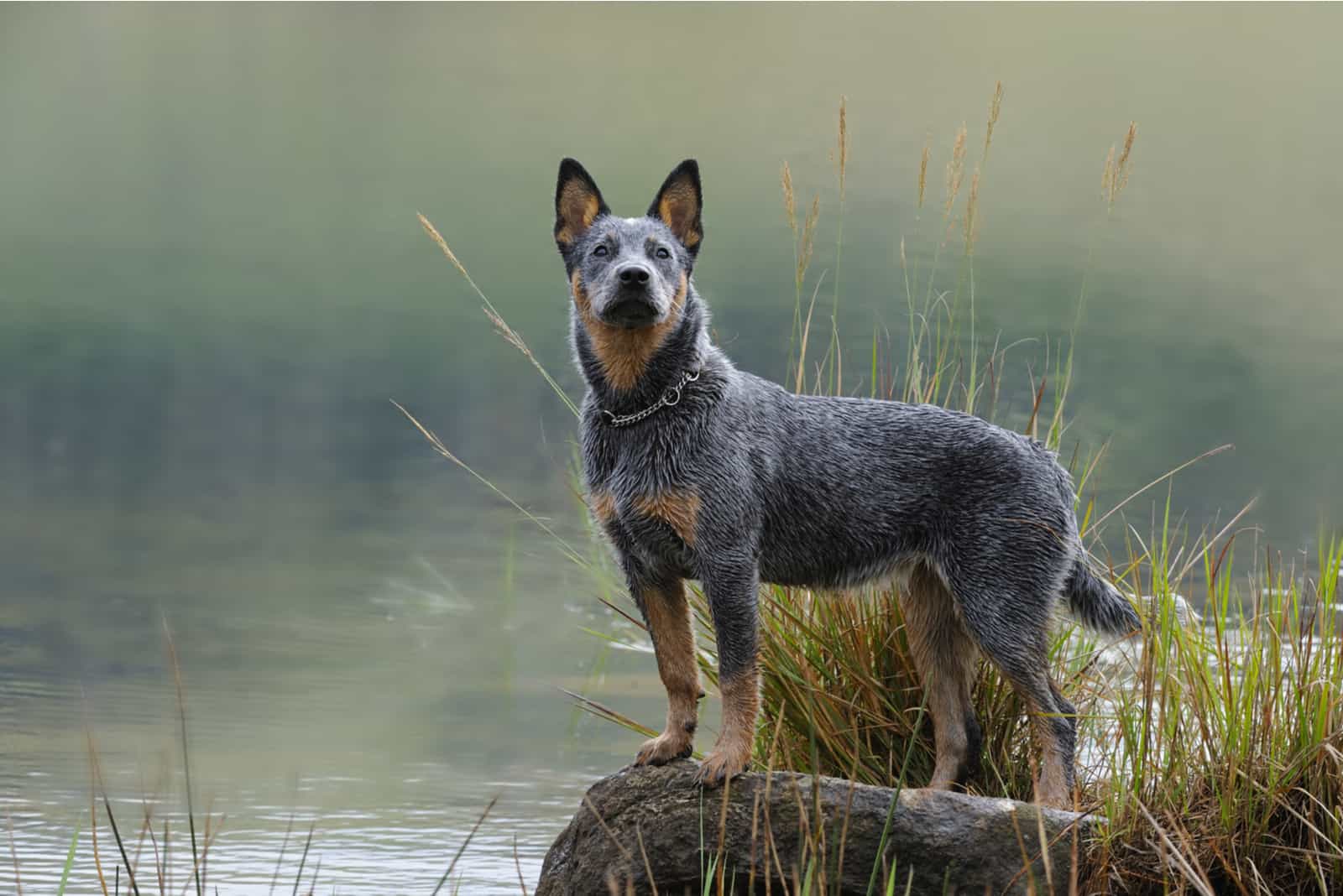
Looks wise, the Blue Heeler dog is very similar to the German Shepherd, albeit coming in a smaller package.
His average size comes in at around 18-19 inches, give or take a few, and it’s only an inch of difference for the average between the male and female representatives of the breed.
The weight is where the difference ends up being, coming in at around 35 to 45 pounds on average for males, and a little bit less for females at around 40-ish pounds.
The dog has a relatively muscular build, neatly packed into that medium-sized body, resembling that of an athlete.
The ears are somewhat pointed and raised up, akin to the GSD, and have hair on the inside to help filter out any stray debris that would otherwise find itself inside the ear by chance.
An Australian Cattle dog’s muzzle is of standard length, with a less pronounced face than his competitor, making him appear more amiable rather than imposing.
The tail is relatively soft and bushy.
All Australian Cattle dogs are born with a white coat which starts showing signs of red and blue coloration after they reach around a month of age.
Some of the white hair does stay though, giving him this wise look of an older, more experienced canine, regardless of age.
Their fur is made out of a double coat which is smooth to the touch, but more importantly, helps the dog tolerate both hot and cold weather which is often the case with Australia’s unpredictable climate.
RELATED: Blue Heeler Growth Chart – How Big Will Your Blue Heeler Get?
Temperament
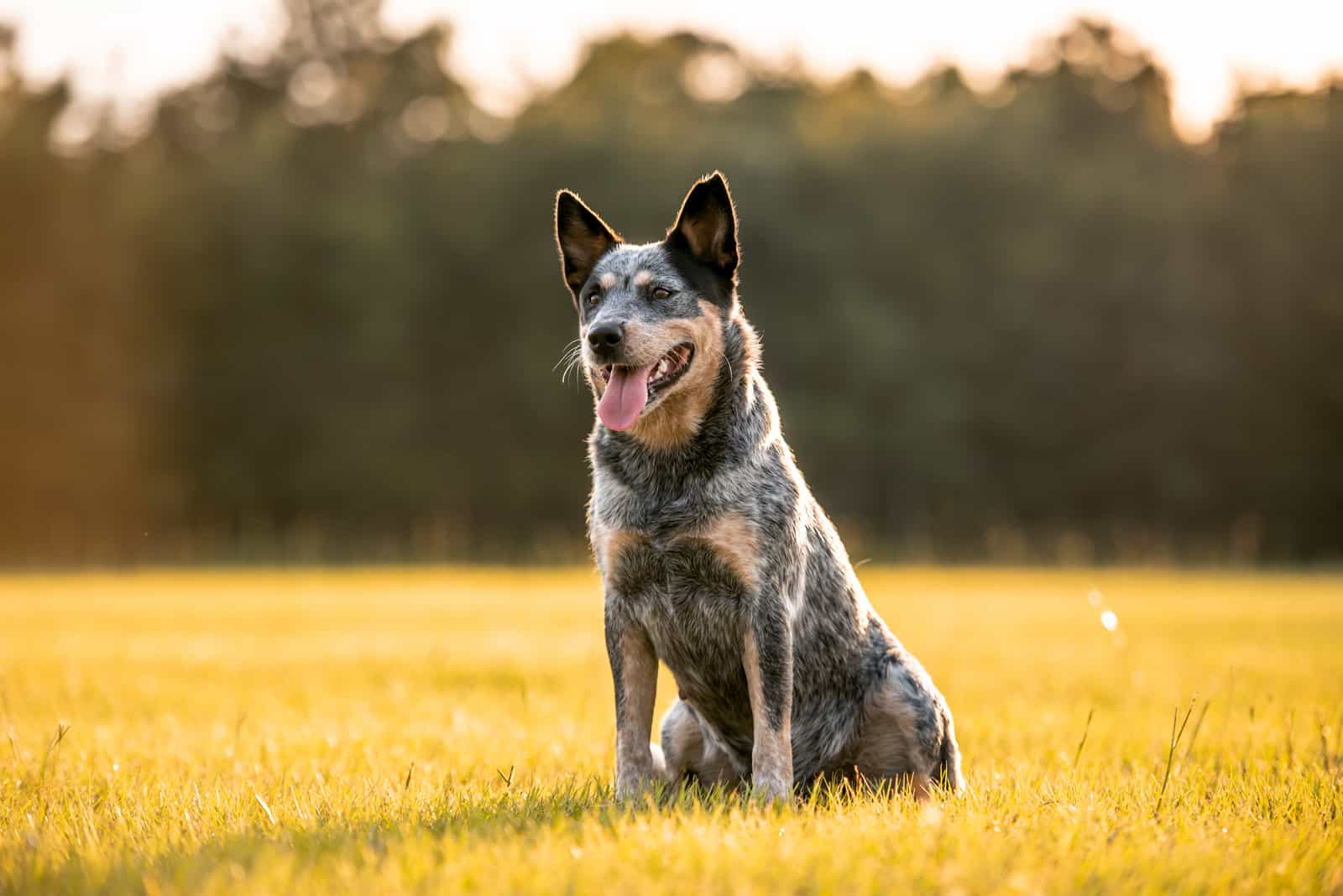
The Blue Heeler dog is definitely one of the more intelligent dog breed types with high energy levels.
Both of these traits have leaned into allowing him to become an excellent herding and working dog, a task which challenged him mentally and provided lots of physical activity in the past, but what about using him as a family dog?
Well, deviating from his built in nature, one would need to find different ways to satisfy the dog’s mental and exercise needs.
They require well over 2 hours of physical exertion to help keep them active and in shape.
While that is a rather sizable number, one needs to keep in mind that this is similar to most shepherds or working dogs out there.
That said, should you be able to meet their needs, you’ll be left with a healthy and kid friendly dog that makes for an ideal family pet and decent watch dog.
The kid friendly part may require a bit of early socialization on his part to curb that innate need to nip at them should they get out of line, but other than that it should be mostly fine.
If you’re unable to meet an intelligent dog’s need for companionship though, do be prepared for outbursts of misbehavior fuelled by separation anxiety.
While the Blue Heeler tolerates being left alone better than most other dogs, there’s a limit to that too as they’re inherently social animals, and they’ll often wreck the things they feel your scent most on in order to get your attention.
Speaking of which, they do love their owner, to the point where they may be a bit overprotective over you.
Sure, they tolerate strangers, but they always remain wary and if anything seems suspicious, they’ll leap before they look in order to defend you.
This is why puppy behavioral training is crucial to help them distinguish the right action from the wrong one.
Coat Colors
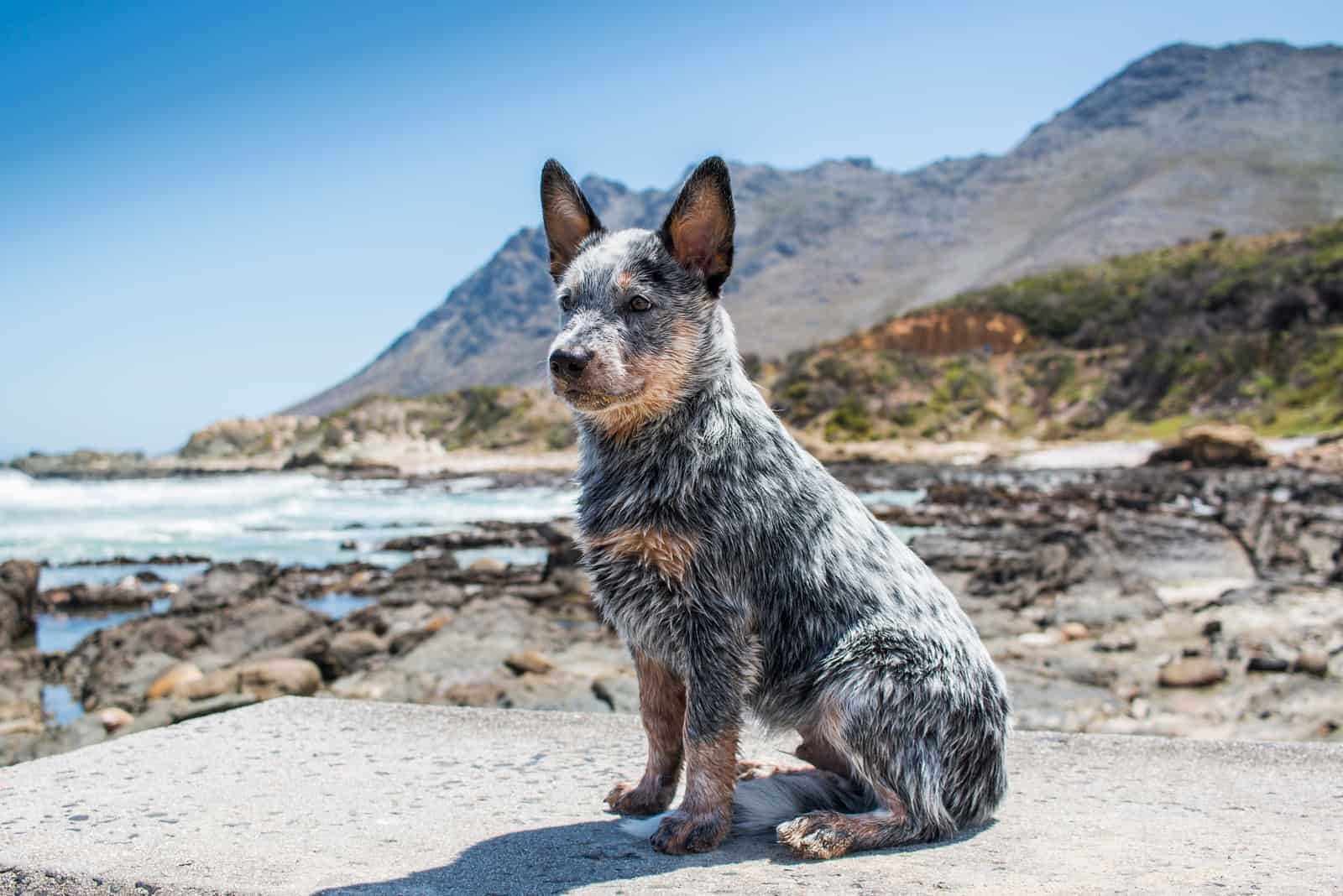
The Blue Heeler dog is a pretty colorful doggo, sporting an impressive number of varied standard and AKC (American Kennel Club) colors, which are as follows:
- Blue
- Blue Mottled
- Blue Speckled
- Red Speckled
- Red Mottled
Surprisingly they don’t have any non-standard colors, which is an oddity all on its own.
SEE ALSO: 5 Blue Heeler Colors And All Markings Explained
Lifespan
Despite being a medium dog breed, the Blue Heeler is relatively healthy, with its only health issues only really affecting aspects of their life that wouldn’t affect their lifespan, so their average life expectancy comes out to around 11-16 years.
The range mostly depending on genes, diet and exercise and a healthy diet can do wonders for a doggo.
It’s certainly longer than large dog breeds like the GSD, but the numbers can vary greatly.
Grooming Needs
Similar to the German Shepherd, the Blue Heeler dog is a light to moderate shedder, which implies similar grooming methods.
You’ll want to brush them once every other day to help get excess hair out, but once shedding season hits, which should be twice a year, you’ll have to swap over to daily brushing.
As for bath time, that remains standard, once every 6 weeks as these dogs often don’t really need much more than that, and if you do it too frequently you risk irritating their skin.
And, naturally, nail care should be done weekly, or at least a check-up for one before getting the nails trimmed to make sure no infection has started to take root.
Health Issues
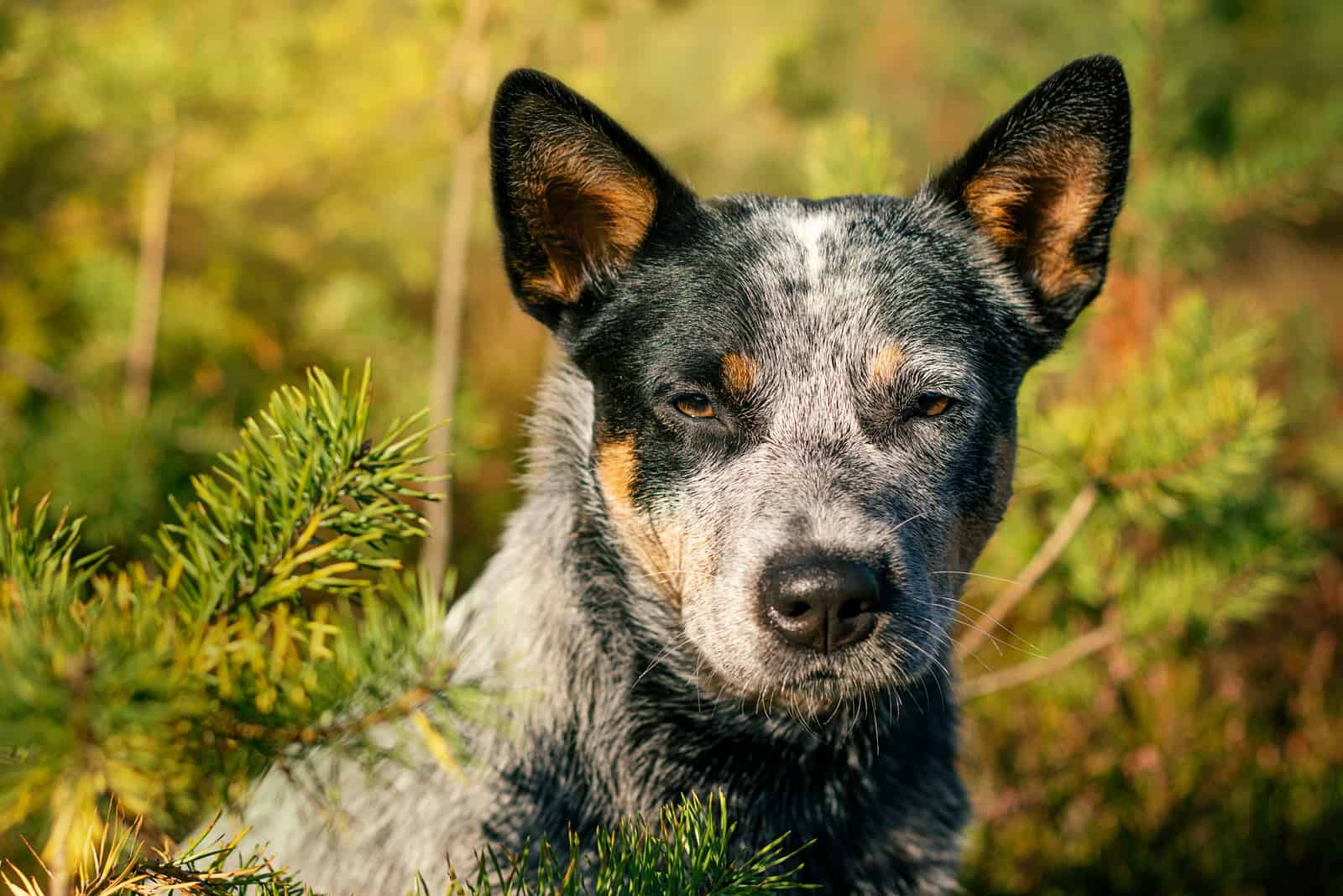
The Blue Heeler dog, while physically active, is still prone to a number of health conditions, most of which are hereditary, but some are those that affect most other dogs.
Here are some of the more common ones:
Elbow and Hip Dysplasia
Similar to every medium and large dog breed, and its competitor breed in this case, the Blue Heeler dog is susceptible to hip and elbow dysplasia.
The same method of treatment applies too, keep your dog at a healthy weight and far away from obesity, though if your dog is born genetically predisposed to suffer from it, there isn’t much you can do aside from easing his pains.
Patellar Luxation
A luxating patella is another bone related health problem, albeit this one can be remedied via surgical procedure.
It’s a condition where the kneecap falls out of place and causes your pooch growing discomfort which will only worsen the longer it’s left untreated.
It’s best to fix it early to provide your dog with some relief.
Bloat
Yet another issue that the Australian Cattle Dog shares with the German Shepherd and any other dog.
To not explain it again, the most effective method of prevention is teaching your doggo how to pace himself when eating to minimize the risk of this particularly heavy health problem occurring.
While it can be reversed, it’s better to prevent than to cure in any case by removing any unnecessary weight gain.
Progressive Retinal Atrophy (PRA)
A health issue that’s common with a number of dogs, Progressive Retinal Atrophy.
It’s a condition where the retinal rods and cones deteriorate over time, leading to a procedural loss of vision, starting with night vision and progressing to regular sight.
It will eventually lead to total blindness and there isn’t really a cure for it, but it also isn’t a fatal disease.
Your dog can live his life without much extra difficulty as long as you’re there to assist him.
While breeders always do their best to weed out these hereditary diseases, a few will always slip by or re-emerge in a generation.
Epilepsy
Congenital Deafness
The final inherited issue that your dog may encounter is deafness. It may appear at any point during his life, some may even be born deaf.
While the chances aren’t all too high, they’re definitely predisposed toward the particular problem, but, much like with PRA, it shouldn’t affect his day to day life too harshly or his life expectancy.
That said, I hope that he doesn’t end up suffering from both because that’s one deadly combination.
Cost
The cost of a purebred Blue Heeler Dog ranges somewhat lower than the German Shepherd, coming in at around $400 to $1200 but averages at around $600 to $800 if you don’t care too much about standard AKC colors.
The cost itself will depend from breeder to breeder too, so be sure to do your research beforehand.
German Shepherd Vs Blue Heeler: The Comparison
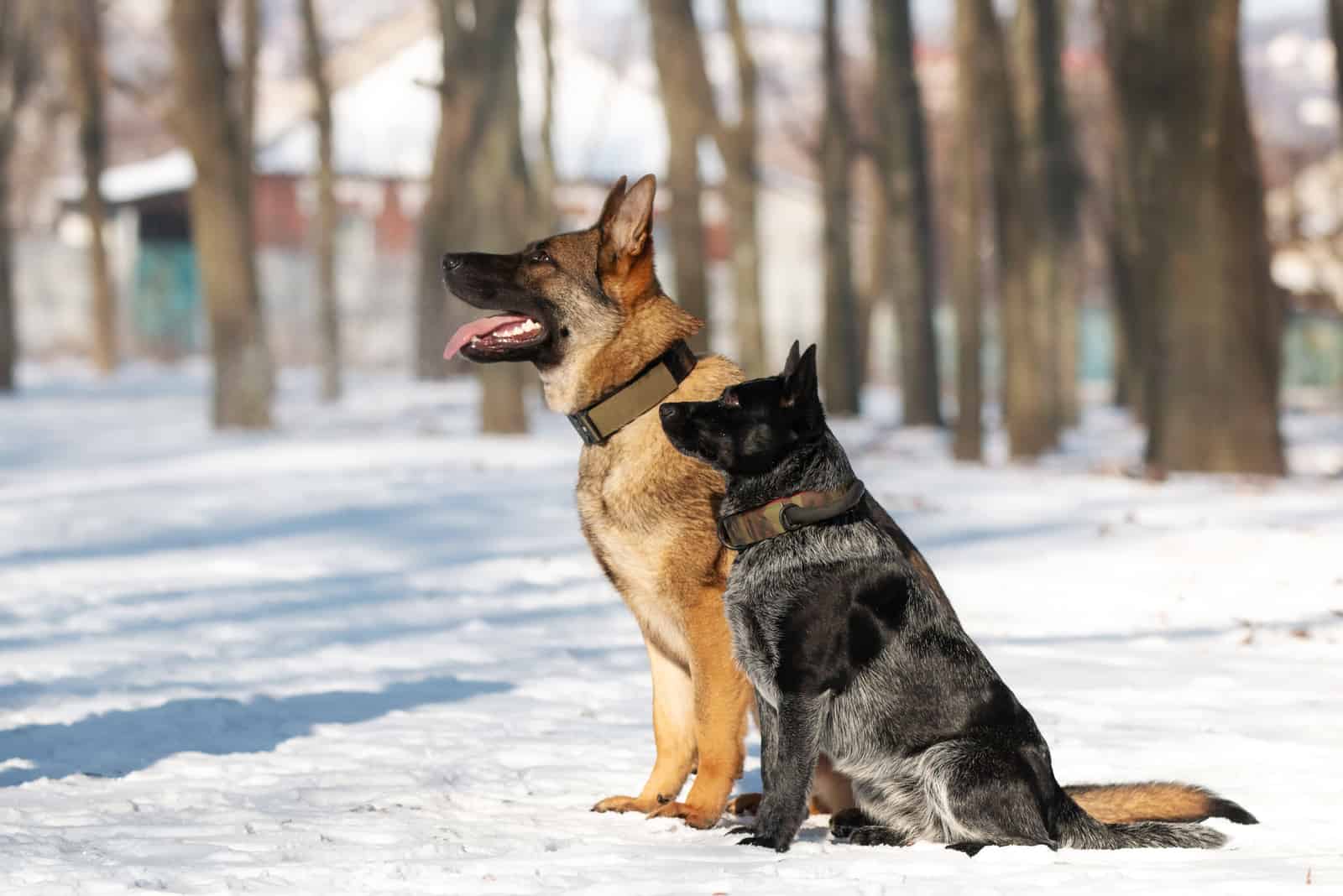
With everything in the open now, at least most of the important details, it’s time to see which of these two exceptional representatives of the canine world is a better choice on average
The Appearance: The German Shepherd Wins
While both have wonderful and unique aesthetic traits on their own despite sharing a resemblance, the German Shepherd wins out due to having more coat color options to choose from whereas the Australian Cattle dog only really has two different ones with a few variations.
The Temperament: The Blue Heeler Wins
Both sides exhibit a great degree of trainability, and, while the GSD can perform more roles than the Blue Heeler, be it a rescue dog, police dog, or otherwise, the latter is ultimately much easier to work with in comparison.
The Lifespan: The Blue Heeler Wins
The GSD isn’t known to be the longest lived breed, and is, by default, a large dog breed, meaning his life expectancy falls short to that of the livelier medium dog that is the Blue Heeler who can reach a potential 16 years of age, if not more.
The Grooming Needs: The Blue Heeler Wins
Another close call as neither of the breeds can really call themselves hypoallergenic or low maintenance, but the Blue Heeler does need to be bathed less often than the GSD.
That said, even that’s debatable as giving your dog a bath isn’t really crucial unless he’s suffering from some sort of infection, so this win doesn’t carry much merit.
Health Issues: The German Shepherd Wins
It’s hard to do a health comparison between two breeds as no issue is guaranteed to spawn nor are any two members of the breed the same.
Instead, we have to look at it as a whole, and the increased likelihood of the Blue Heeler to end up both blind and deaf can be a pretty devastating combination for a dog, and thus, I give the GSD the win in this category.
The Cost: The Blue Heeler Wins
In the final category, it’s, once again, a relatively close battle, but the average price of a Blue Heeler dog is overall lower than that of the GSD, even though they’re both equally affordable dog options.
German Shepherd Vs Blue Heeler: The Winner Is…
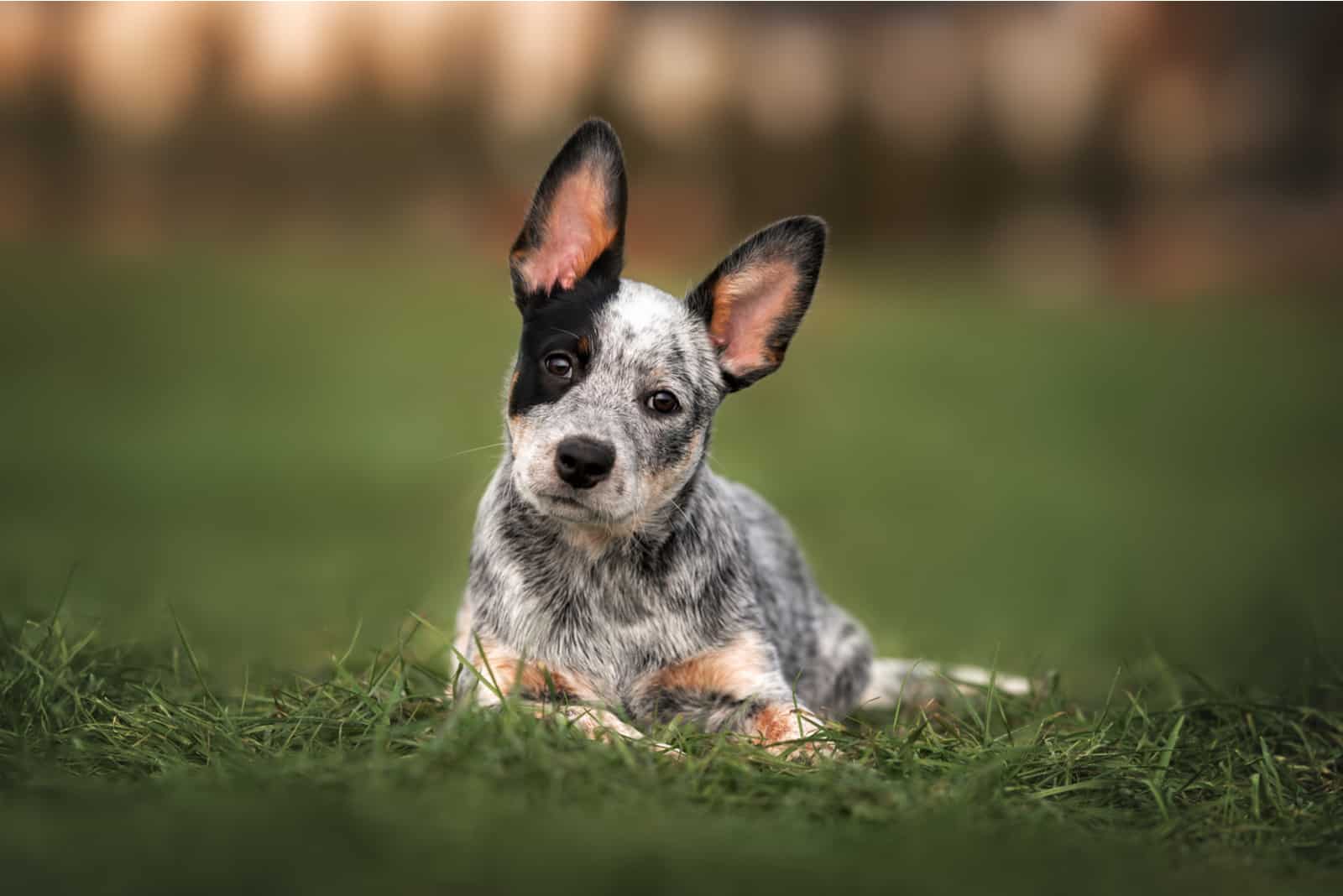
As it is with most versus articles like these, and part of my own bias, the comparisons end up being quite close, but I do believe that the Blue Heeler edges out in the end, ever so slightly.
Don’t get me wrong, both breeds are great, and there are more factors out there to consider than just the ones given here, but the subjective opinion is that the Blue Heeler is smaller and easier to train, and makes for a better pet for the average family.
That said, if you’re looking specifically for a watch or guard dog, and you’re capable of coming out on top of a GSD’s training, then the German Shepherd may be the right option for you.
FAQs
Which Of The Two Dogs Is Better For Kids?
When looking at which of the dogs makes a better family pet, their temperament certainly plays a big part in the decision, however, part of this eligibility lies on both you and the dog’s breeder.
Sure, the GSD is known to be a bit more aggressive and serious, but so is the Blue Heeler here, albeit to a slightly lesser extent.
That is, unless you provide them with early behavioral training.
Much like with humans, it’s important to allow your dogs to build up social bonds as pups and to be taught about what’s okay to do and what isn’t at an early age by having them hang around fellow dogs and young children.
The earlier it’s done, the better the knowledge sticks and the easier it’ll be to have your dog act in a friendly manner toward both kids and other dogs, avoiding any potential accidents and discomfort.
And both sides have a lot to learn.
The German Shepherd’s fault often lies in his overprotectiveness towards the kids of his owner while being extra wary of other dogs and strangers, even if they’re distant family members.
The Blue Heeler, on the other hand, carries more of that herding mentality toward kids and is more likely to nip at their heels to get them to stop misbehaving, as if he’s corralling cattle, though he isn’t the biggest fan of strangers either.
In Conclusion
In the German Shepherd vs Blue Heeler debate, we learn just how similar two dog breeds can be and what little nuances can set them apart the more we dig into them.
While I have dubbed the Blue Heeler as the winner, keep in mind that that’s a pretty subjective opinion on the matter and that the GSD shouldn’t be discarded over it.
The battle was pretty close, and it doesn’t take other factors into consideration like breeders in your area for the specific breed, what exact purpose you’re looking to get a dog for, or your own personal preference for that matter.
Which is why I wholeheartedly recommend you go over the facts I’ve laid out for you and figure out which of these two would suit you best, because, trust me when I say, that they’ll both make for great companions for the duration of their lives.
Until next time, pet parents.
RELATED LINKS:
- How To Identify A Full-Blooded German Shepherd
- Blue Heeler Feeding Chart: Crunching The Kibble
- 11 Best Sable German Shepherd Breeders In The US
- 7 Types Of German Shepherds – All Variations In One Place
- The Top 10 Best Blue Heeler Breeders In The U.S.
- The German Shepherd Ears Chart: 7 Things You Need To Know
- German Shepherd Raw Diet Habits: Yes Or No?
- Top 7 German Shepherd Breeders In Alabama
- How Often Should You Bathe A German Shepherd? 10 Bathing Tips















